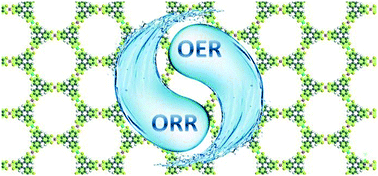当前位置:
X-MOL 学术
›
Catal. Sci. Technol.
›
论文详情
Our official English website, www.x-mol.net, welcomes your
feedback! (Note: you will need to create a separate account there.)
First-principles design of bifunctional oxygen reduction and evolution catalysts through bimetallic centers in metal–organic frameworks†
Catalysis Science & Technology ( IF 4.4 ) Pub Date : 2018-06-28 00:00:00 , DOI: 10.1039/c8cy00675j Peng Zhang 1, 2, 3, 4, 5 , Xuejing Yang 1, 2, 3, 4, 5 , Wang Gao 2, 5, 6, 7 , Xiuli Hou 1, 2, 3, 4, 5 , Jianli Mi 1, 2, 3, 4, 5 , Lei Liu 1, 2, 3, 4, 5 , Jun Huang 8, 9, 10, 11 , Mingdong Dong 12, 13, 14, 15 , Catherine Stampfl 10, 11, 16, 17
Catalysis Science & Technology ( IF 4.4 ) Pub Date : 2018-06-28 00:00:00 , DOI: 10.1039/c8cy00675j Peng Zhang 1, 2, 3, 4, 5 , Xuejing Yang 1, 2, 3, 4, 5 , Wang Gao 2, 5, 6, 7 , Xiuli Hou 1, 2, 3, 4, 5 , Jianli Mi 1, 2, 3, 4, 5 , Lei Liu 1, 2, 3, 4, 5 , Jun Huang 8, 9, 10, 11 , Mingdong Dong 12, 13, 14, 15 , Catherine Stampfl 10, 11, 16, 17
Affiliation

|
Rational design of efficient bifunctional oxygen electrocatalysts for the oxygen reduction reaction (ORR) and oxygen evolution reaction (OER) with low cost and high activity is greatly desired for the realization of rechargeable metal–air batteries and regenerative fuel cells. Metal–organic frameworks (MOFs) are promising oxygen electrocatalysts due to their flexible structures, ultrahigh surface area, porosity, and high catalytic activity. However, it is still a significant challenge to achieve bifunctional oxygen electrocatalysts based on MOF materials with comparable activity and durability. Herein, the electronic and catalytic properties of M3(triphenylene-2,3,6,7,10,11-hexathiol)2 [M3(THT)2] nanosheets with nine different central metal atoms (Fe, Co, Ni, Ru, Rh, Pd, Os, Ir and Pt) are investigated systematically based on density functional theory. It is found that the electronic and catalytic properties of M3(THT)2 nanosheets are mainly based on the central metal atoms. Of the nine different M3(THT)2 nanosheets considered, Co3(THT)2 displays the best ORR catalytic activity, while Fe3(THT)2 shows the best OER catalytic activity. Due to the separation by THT molecules, the electronic and catalytic properties of MS4 groups in bi-metallic M3(THT)2 nanosheets are consistent with their single-metal counterparts. Bi-metallic FexCo3−x(THT)2 nanosheets exhibit bifunctional catalytic activity for both the ORR and OER. The ORR occurs on the Co atom, while the active site for the OER is the Fe atom. With desirable architecture and excellent electrocatalytic activities, the FexCo3−x(THT)2 nanosheets can be considered as promising bifunctional oxygen electrocatalysts.
中文翻译:

通过金属-有机骨架中的双金属中心设计双功能氧还原和逸出催化剂的第一原理†
为了实现可充电金属-空气电池和可再生燃料电池,非常需要合理设计低成本,高活性的氧还原反应(ORR)和氧释放反应(OER)的高效双功能氧电催化剂。金属有机骨架(MOFs)由于其灵活的结构,超高的表面积,孔隙率和高催化活性而成为有前途的氧气电催化剂。然而,基于MOF材料获得具有可比的活性和耐久性的双功能氧电催化剂仍然是重大挑战。在此,M 3(三亚苯基-2,3,6,7,10,11-六硫醇)2 [M 3(THT)2]基于密度泛函理论,系统研究了具有9种不同中心金属原子(Fe,Co,Ni,Ru,Rh,Pd,Os,Ir和Pt)的纳米片。发现M 3(THT)2纳米片的电子和催化性能主要基于中心金属原子。在考虑的九种不同的M 3(THT)2纳米片中,Co 3(THT)2显示出最佳的ORR催化活性,而Fe 3(THT)2显示出最佳的OER催化活性。由于THT分子的分离,双金属M 3(THT)2中的MS 4基团的电子和催化性能纳米片与单金属片是一致的。双金属Fe x Co 3- x(THT)2纳米片对ORR和OER均表现出双功能催化活性。ORR发生在Co原子上,而OER的活性位是Fe原子。具有理想的结构和出色的电催化活性,Fe x Co 3- x(THT)2纳米片可被视为有前途的双功能氧电催化剂。
更新日期:2018-06-28
中文翻译:

通过金属-有机骨架中的双金属中心设计双功能氧还原和逸出催化剂的第一原理†
为了实现可充电金属-空气电池和可再生燃料电池,非常需要合理设计低成本,高活性的氧还原反应(ORR)和氧释放反应(OER)的高效双功能氧电催化剂。金属有机骨架(MOFs)由于其灵活的结构,超高的表面积,孔隙率和高催化活性而成为有前途的氧气电催化剂。然而,基于MOF材料获得具有可比的活性和耐久性的双功能氧电催化剂仍然是重大挑战。在此,M 3(三亚苯基-2,3,6,7,10,11-六硫醇)2 [M 3(THT)2]基于密度泛函理论,系统研究了具有9种不同中心金属原子(Fe,Co,Ni,Ru,Rh,Pd,Os,Ir和Pt)的纳米片。发现M 3(THT)2纳米片的电子和催化性能主要基于中心金属原子。在考虑的九种不同的M 3(THT)2纳米片中,Co 3(THT)2显示出最佳的ORR催化活性,而Fe 3(THT)2显示出最佳的OER催化活性。由于THT分子的分离,双金属M 3(THT)2中的MS 4基团的电子和催化性能纳米片与单金属片是一致的。双金属Fe x Co 3- x(THT)2纳米片对ORR和OER均表现出双功能催化活性。ORR发生在Co原子上,而OER的活性位是Fe原子。具有理想的结构和出色的电催化活性,Fe x Co 3- x(THT)2纳米片可被视为有前途的双功能氧电催化剂。











































 京公网安备 11010802027423号
京公网安备 11010802027423号